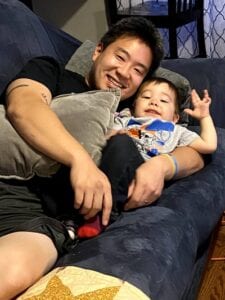When their son Quinton was diagnosed with late-onset Krabbe disease through newborn screening, Laura and Ryan Nitahara were initially full of questions. What was Krabbe disease? How would this affect their family? But most of all, how could they help? Through research, the Nitahara family discovered KrabbeConnect and the organization’s new KrabbeCURES community united research and engagement study. Empowered by the wealth of resources, Laura and Ryan launched “Quinton’s Quest for a Cure” to amplify awareness of Krabbe disease and raise funds for future research. Recently, Laura and Ryan chatted with Patient Worthy about Quinton, their fundraiser, and the importance of newborn screening.
Quinton
In August 2018, Laura and Ryan happily welcomed Quinton into their lives. But just three weeks after his birth, the family was faced with a unique difficulty.
“The pediatrician was the first one to call me when Quinton was three weeks old to tell me that he may have tested low on a specific enzyme,” says Laura. “It had the potential to be Krabbe disease. We went through follow-up tests. But our pediatrician didn’t know what Krabbe disease was, so his interpretation was that the follow-up test was negative.”
Ryan agrees, sharing, “I don’t even think it’s a very well-known disease at all.”

However, through further screening and testing, as well as visits to a geneticist, the Nitahara family determined that Quinton did indeed have late-onset Krabbe disease. To learn more about the condition, they worked with Dr. Maria Escolar, a Krabbe disease expert who heads the NDRD at the University of Pittsburgh Medical Center (UPMC) Children’s Hospital.
What is Krabbe Disease?
KrabbeConnect describes Krabbe disease as a rare genetic lysosomal storage disorder (LSD) and neurological condition. Also known as globoid cell leukodystrophy, Krabbe disease occurs when patients lose the myelin sheath (a protective covering) around nerve cells. Krabbe Connect explains that “this protective myelin sheath is essential to insulate the nerves and ensure the rapid transmission of nerve signals throughout the body.” This loss is caused by an enzyme deficiency, which prevents the body from breaking down fatty substances. As a result, Krabbe disease
causes damage to the brain’s white matter, as well as the central and peripheral nervous systems. Around 85-90% of all Krabbe disease cases are classic-infantile. However, the remaining patients, like Quinton, are late-onset. This means that symptoms may not appear until childhood, adolescence, or adulthood.
Because he is late-onset, Quinton currently has no symptoms. But this can be difficult, explains Laura:
“Because we’re part of the Krabbe world, it’s expected for him to fit the picture of what Krabbe disease is. But he doesn’t. Most patients are diagnosed because they’re symptomatic. So we’re a unique voice, even in this community.”
KrabbeConnect
At first, Ryan and Laura turned to family members for comfort. But they also began channeling
their fears into hopes, looking for ways to get involved.
“I found KrabbeConnect by googling Krabbe over and over and over and over,” shares Laura. “I wanted to find some sort of support or advocacy group to give me some direction since it is such a rare disease.”
KrabbeConnect is a rare disease nonprofit organization designed to amplify patient voices and encourage research and potential treatments around Krabbe disease.
Ryan and Laura explain that they wanted to find a way to contribute to Krabbe disease research. This became especially pressing as friends and family began to ask what they could do. Ryan explains:
“We knew we wanted to do something, help in some way. We have an incredible support system. That was really our motivation. We wanted to throw a big fundraiser with a silent auction, different games, kid-friendly activities, stuff for adults.”
On August 17, 2019, Quinton’s Quest for a Cure generated over $40,000 in funding.
KrabbeCURES
Their funds, and experiences, have helped shape KrabbeCURES. This resource is patient-driven, given families the opportunity to engage and share their knowledge. As more participants join, KrabbeCURES will collect data on disease progression and unique family experiences. The goal is to inspire new diagnostic options and treatments.
To learn more about KrabbeCURES, or see how you can join, head here.
Advocacy
Currently, Laura and Ryan remain involved in the Krabbe disease community. The president of KrabbeConnect often sends opportunities for involvement their way, from parent panels and speaking to an FDA board to speaking at a KrabbeConnect-Legacy of Angels symposium.
Moving forward, they hope to continue solidifying their spot as advocates within the rare disease community. Laura and Ryan note that the diagnosis:
“definitely changed our lives forever. Everyone has things in their life that are negative. This is ours, this is our reality. But what we do with this will define our place in the rare disease community. So it is so important to continue to fundraise, continue to keep ourselves involved and educated, because there is a bigger reason for us to be in this world.”
The family hoped to hold a second Quinton’s Quest for a Cure fundraiser this year to contribute to finding a cure. Unfortunately, it is currently on hold thanks to COVID-19.
Newborn Screening
One of the most powerful things that the Nitahara family discovered during their journey is the importance of newborn screening. KidsHealth describes newborn screening as:
“a public health service done in each U.S. state. Every newborn is tested for a group of [rare genetic, hormone-related, and metabolic] disorders that aren’t otherwise found at birth.”
However, there is one huge oversight in American newborn screening: there is no continuity in
testing between states. While there are recommendations on what disorders should be screened
for, the decision is ultimately up to each state.
Krabbe disease was not mandated in Illinois as part of the newborn screening panel until 2007, when state legislators passed the Newborn Metabolic Screening Act (410 ILCS 240). When the Act was passed, legislators hoped to begin screening for Krabbe disease by 2010.
Then 2010 passed. And 2011. 2012. It took Illinois until December 2017, ten full years after the Act was passed, to begin testing infants for Krabbe disease. If the infantile form of Krabbe disease is caught at birth, doctors can help using a cord-blood stem cell transplant. However, because Illinois failed to screen for this condition, at least three infants born with this rare condition were affected. As of 2017, New York, Missouri, Kentucky, Ohio, and Illinois screen newborns for Krabbe disease. While Louisiana, New Jersey, New Mexico, Pennsylvania, and Tennessee passed Acts to screen, no programs were implemented. These are only 10 states out of the 50 that make up
the United States. So Krabbe disease testing is minimal at best.
Making the Change
When asked what they wanted to share, Ryan reiterated the importance of newborn screening. Being able to allow families to catch this condition early will allow for better treatment and perhaps even new treatments in the future. However, it is crucial to speak up to lawmakers and policymakers to enact this change.
Patient advocacy plays a role in this. Being able to perform research and show an advisory board the impact of early treatment and diagnosis is the first step in expanding newborn screening. Laura explains:
“If you’re picked up as an infant with Krabbe disease, those first weeks are vital. If it isn’t picked up on the newborn screening and symptoms are occurring, it is too late for that treatment. Patient stories and patient advocacy are hugely significant in a board’s decision.”
Newborn screening also allows for families of children with late-onset Krabbe disease to be proactive about their decision making. They are able to do research, participate in advocacy, and prepare for the day when symptoms might appear.

Additionally, both Ryan and Laura hope that more information on Krabbe disease is shared with doctors and other medical professionals. While they love their pediatrician, they do explain that not much information was given to them on the day of diagnosis. Having any verbiage or blurb that tells a doctor what a condition is would provide more guidance to families. The pair share:
“I would love for whoever is delivering that life-altering news to really know about the conditions and how to deliver the news. We’re lucky that we were able to get answers quickly but if we had to sit and stew on that for any longer, it would have been traumatizing.”
As they continue to advocate for Krabbe disease research, Laura and Ryan are also enjoying their time with Quinton, who they describe as having an absolutely stellar personality!
Want to learn more about Krabbe disease or how you can get involved? Check out KrabbeConnect!


